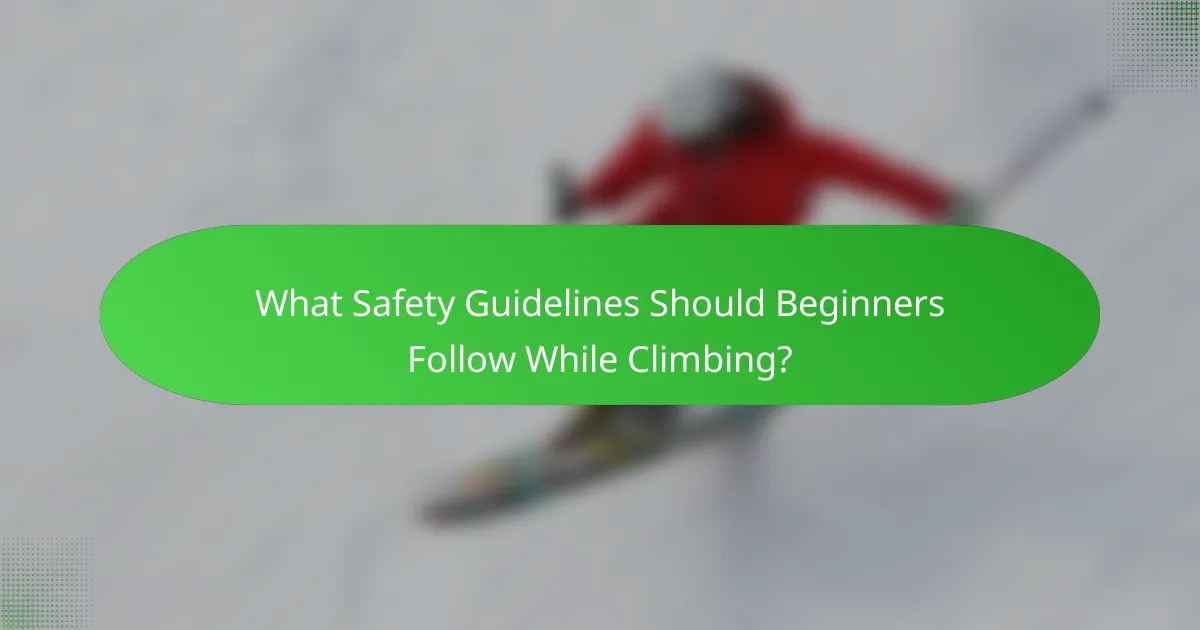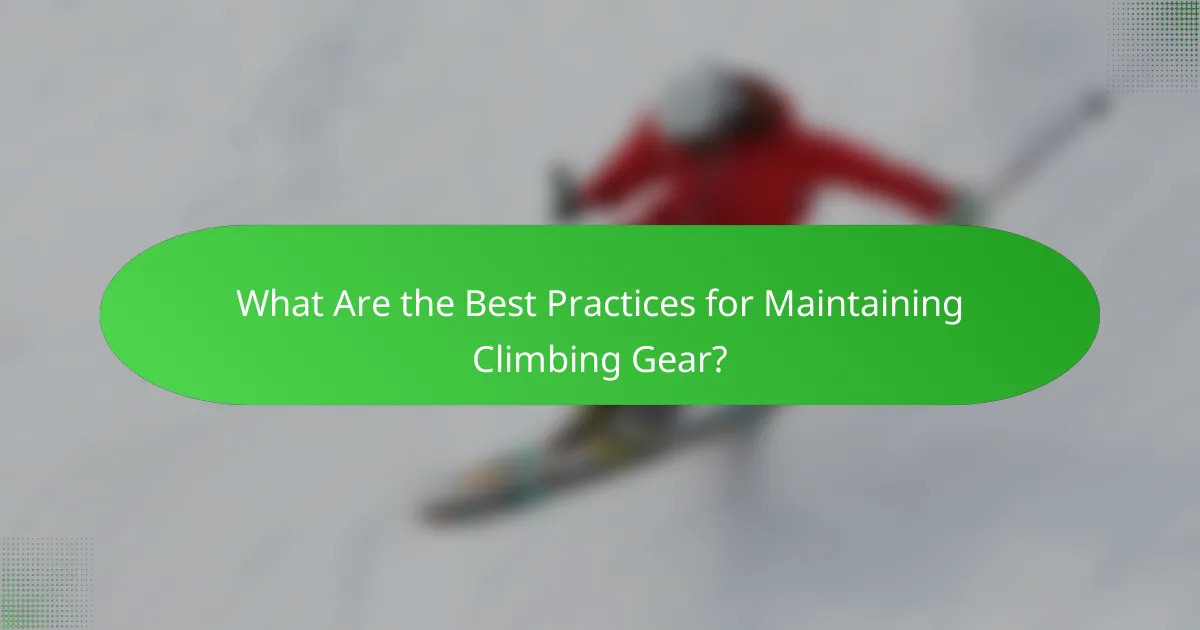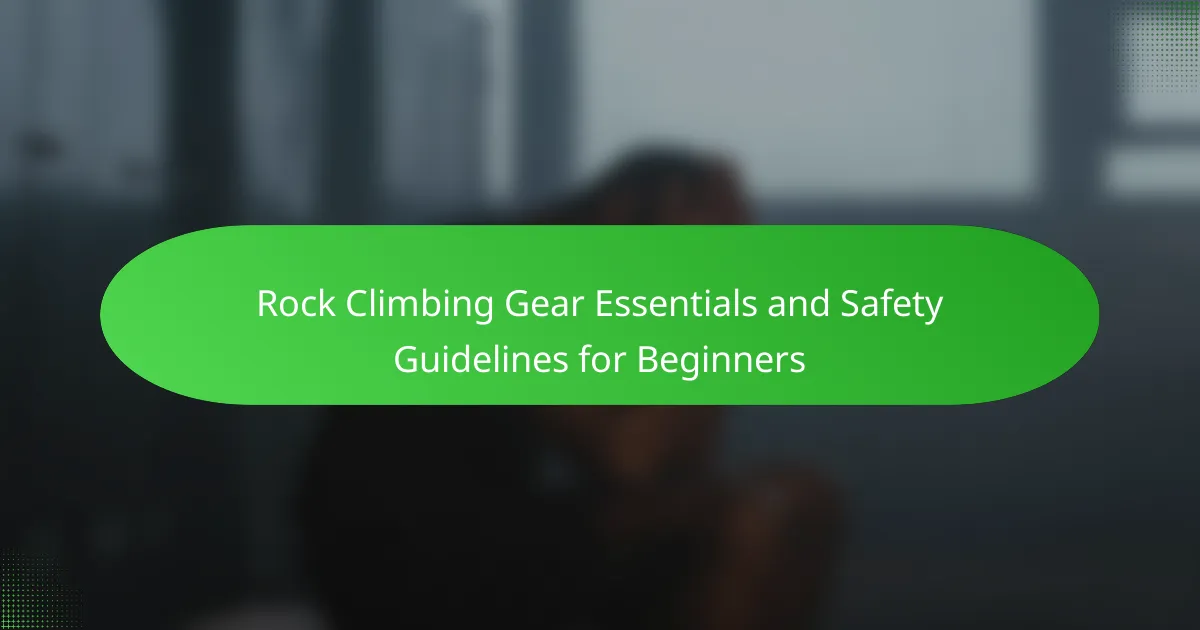Rock climbing can be exhilarating but poses safety challenges for beginners. Essential gear includes climbing shoes, harnesses, helmets, and ropes for protection and performance. Following safety guidelines, such as checking equipment and climbing with a partner, is crucial for a secure experience. Regular practice and proper gear maintenance further enhance skills and confidence in the sport.

What Essential Gear Do Beginners Need for Rock Climbing?
Beginners need essential rock climbing gear for safety and performance. Key items include climbing shoes for grip, a harness for safety, a helmet for head protection, and a chalk bag to enhance grip.
1. Climbing Shoes: Provide traction and support.
2. Harness: Secures the climber to the rope.
3. Helmet: Protects against falling debris.
4. Chalk Bag: Keeps hands dry for better grip.
5. Rope: Essential for safety and climbing.
6. Carabiners: Connects gear and secures the rope.
These items ensure a safe and enjoyable climbing experience.
How to Choose the Right Climbing Shoes?
To choose the right climbing shoes, consider fit, type, and intended use. A snug fit enhances performance, while shoe type varies between aggressive, moderate, and neutral styles, catering to different climbing techniques. For beginners, moderate shoes offer versatility and comfort. Prioritise features like rubber quality and closure systems for optimal safety and efficiency.
What are the Key Features of Climbing Harnesses?
Climbing harnesses are designed for safety and comfort, featuring adjustable leg loops, padded waistbands, and gear loops. Key features include weight distribution for optimal support, a belay loop for secure rope attachment, and a safety rating indicating strength. Many harnesses also offer unique attributes like quick-adjust systems and lightweight materials for enhanced mobility. Additionally, rare features may include integrated safety systems or specific designs for particular climbing styles.
Which Types of Climbing Ropes Should Beginners Consider?
Beginners should consider dynamic and static climbing ropes. Dynamic ropes stretch to absorb falls, making them ideal for sport climbing. Static ropes, while less stretchy, are better for rappelling and rescue scenarios. Look for ropes with a diameter of 9.5 to 10.5 mm, offering a balance of weight and durability.
How to Select the Best Carabiners for Your Climbing Needs?
To select the best carabiners for your climbing needs, consider their type, strength rating, and locking mechanism. Focus on carabiners that are lightweight yet durable, with a minimum strength rating of 20 kN for safety. Look for locking mechanisms like screw-lock or auto-lock for added security. Additionally, choose the right shape; oval carabiners are versatile, while D-shaped ones offer better strength-to-weight ratios.
What is the Importance of Chalk and Chalk Bags in Climbing?
Chalk and chalk bags are crucial for rock climbing as they enhance grip and reduce moisture. Chalk absorbs sweat, allowing climbers to maintain better control on holds. A chalk bag provides easy access, ensuring climbers can reapply as needed. This combination improves safety and performance, making it essential for both beginners and experienced climbers.
How Do Helmets Enhance Safety While Climbing?
Helmets significantly enhance safety while climbing by protecting the head from falling objects and impacts. They are designed to absorb shock and distribute force, reducing the risk of injury. A well-fitted helmet can prevent concussions and skull fractures during falls or accidents. Additionally, modern climbing helmets often feature ventilation and lightweight materials, improving comfort without compromising safety. Choosing a helmet that meets safety standards, such as UIAA or CE certifications, ensures reliable protection.

What Safety Guidelines Should Beginners Follow While Climbing?
Beginners should prioritise safety by following essential guidelines during rock climbing. Always wear a helmet to protect against falling debris. Use proper climbing gear, including harnesses and climbing shoes, that fit correctly. Ensure your knots are secure and double-check them before climbing. Climb with a partner who can provide support and assistance. Familiarise yourself with climbing routes and conditions to avoid hazards. Lastly, stay hydrated and aware of your physical limits to prevent injuries.
Why is Proper Technique Important in Preventing Injuries?
Proper technique is crucial in preventing injuries during rock climbing. It ensures optimal body positioning, reduces strain, and enhances grip stability. Proper technique minimises the risk of falls and overuse injuries, promoting safer climbing experiences. Beginners should focus on mastering foot placements, handholds, and body movements to build a strong foundation. Prioritising technique over speed or difficulty allows climbers to progress safely while enjoying the sport.
How to Conduct a Safety Check on Your Gear?
To conduct a safety check on your gear, inspect each item thoroughly before use. Start with harnesses, checking for frays or wear. Examine carabiners for smooth operation and locking mechanisms. Inspect ropes for cuts or abrasions. Review helmets for cracks or dents. Finally, ensure all gear is properly stored and organised.
What are the Best Practices for Climbing with a Partner?
To ensure safe and enjoyable climbing, communicate clearly with your partner, establish roles, and check gear together. Use a pre-climb checklist to verify harnesses, knots, and belay devices. Regularly practice safety techniques, such as falling and catching, to build trust and confidence. Always maintain situational awareness and adapt to changing conditions.
How Does Weather Impact Climbing Safety?
Weather significantly impacts climbing safety by affecting rock conditions, visibility, and temperature. Rain can make rocks slippery, increasing fall risk. High winds can destabilise climbers and equipment. Temperature extremes can lead to hypothermia or heat-related illnesses. Monitoring weather forecasts and conditions is crucial for ensuring a safe climbing experience.

What Unique Challenges Do Beginners Face in Rock Climbing?
Beginners in rock climbing face challenges like fear of heights, lack of experience, and difficulty in selecting appropriate gear. Many struggle with understanding safety protocols and climbing techniques.
Fear of heights can hinder progress and confidence. Beginners may also find it challenging to trust their equipment and belayers. Additionally, the learning curve for effective communication with climbing partners can be steep.
Selecting the right gear is crucial; beginners often feel overwhelmed by choices, such as harnesses, shoes, and ropes. Understanding how to use gear correctly is essential for safety and performance.
Finally, beginners may encounter physical challenges, including strength and endurance limitations. As a result, they must develop their skills gradually to build confidence and competence in the sport.
How to Overcome Fear and Anxiety While Climbing?
To overcome fear and anxiety while climbing, focus on preparation and mindset. Start by familiarising yourself with your gear, as knowing how to use it boosts confidence. Practice deep breathing techniques to calm your nerves before and during climbs. Gradually expose yourself to heights through controlled environments, building comfort over time. Establish a support system with experienced climbers who can provide encouragement and guidance. Setting small, achievable goals during your climbs can help you track progress and reduce anxiety. Remember, mental preparation is as crucial as physical readiness in climbing.
What are Common Mistakes Beginners Make and How to Avoid Them?
Beginners often make mistakes like inadequate gear selection and neglecting safety protocols. To avoid these, prioritise essential gear, learn proper techniques, and always check equipment before climbing.
1. Skipping gear checks: Always inspect harnesses, ropes, and carabiners for damage.
2. Choosing improper footwear: Use climbing shoes designed for your climbing style.
3. Ignoring safety practices: Familiarise yourself with belaying techniques and communication signals.
4. Overestimating abilities: Start with easier routes to build confidence and skills.
5. Climbing without a partner: Always have a climbing partner for safety and support.

How Can Beginners Progress in Their Climbing Skills?
Beginners can progress in their climbing skills by focusing on proper gear selection and adhering to safety guidelines. Essential gear includes climbing shoes, harnesses, and helmets, which enhance performance and safety. Learning to use this equipment correctly is crucial.
Regular practice at climbing gyms or outdoor climbing sites builds muscle memory and confidence. Joining climbing communities or classes provides support and tips from experienced climbers.
Setting achievable goals helps track progress. For example, aim to complete specific routes or improve technique. Additionally, understanding climbing techniques, such as footwork and body positioning, significantly enhances skill development.
Monitoring safety practices, like checking gear and practicing falls, ensures a secure climbing experience. This focus on safety and skill development fosters a sustainable climbing journey.
What Role Do Climbing Gyms Play in Skill Development?
Climbing gyms play a crucial role in skill development for beginners. They provide a controlled environment to practice techniques, build strength, and enhance problem-solving skills.
In climbing gyms, beginners can access various climbing walls that cater to different skill levels. These facilities often offer classes and coaching, enabling climbers to learn proper techniques and safety protocols. Additionally, climbing gyms foster a community atmosphere, encouraging peer support and motivation.
The availability of diverse routes allows climbers to experience different styles and challenges, aiding in their overall development. Regular practice in a gym setting can accelerate skill acquisition, making it an essential component of a climber’s training regimen.
How to Set Realistic Goals for Climbing Progression?
Setting realistic goals for climbing progression involves assessing your current skill level, identifying specific targets, and creating a structured plan. Break your goals into short-term and long-term objectives for clarity.
1. Assess current skills: Evaluate your climbing abilities and identify strengths and weaknesses.
2. Set specific targets: Define clear, measurable goals such as climbing a certain grade or mastering a technique.
3. Create a training plan: Develop a structured routine that includes climbing sessions, strength training, and flexibility work.
4. Monitor progress: Regularly review your achievements and adjust your goals as needed to stay motivated.
By following these steps, you can create a focused approach to your climbing development.

What Are the Best Practices for Maintaining Climbing Gear?
To maintain climbing gear effectively, regularly inspect, clean, and store it properly. Check for wear, damage, or corrosion, especially on ropes, carabiners, and harnesses.
1. Inspect gear before and after each use.
2. Clean ropes with mild soap and water; air dry completely.
3. Store gear in a cool, dry place away from direct sunlight.
4. Replace any gear showing signs of significant wear or damage.
These practices ensure safety and longevity, keeping gear in optimal condition for climbing adventures.
How Often Should You Inspect Your Climbing Equipment?
Inspect your climbing equipment at least once a month. Regular inspections help identify wear and tear, ensuring safety during climbs. Additionally, inspect gear before and after significant trips. Look for fraying, corrosion, and any unusual signs of damage. Proper maintenance prolongs the life of your gear and enhances safety.
What are the Signs of Wear and Tear in Climbing Gear?
Signs of wear and tear in climbing gear include frayed ropes, worn harnesses, damaged carabiners, and cracked helmets. Inspect gear regularly for these indicators to ensure safety. Ropes showing fuzziness or cuts may compromise strength. Harnesses with worn webbing or broken buckles should be replaced. Carabiners that do not lock properly or have visible cracks can fail during use. Helmets with dents or cracks should not be used. Regular checks can prolong gear life and enhance safety.
How to Properly Store Your Climbing Gear?
To properly store your climbing gear, keep it clean, dry, and organised. Store ropes and harnesses in a cool, dark place to prevent UV damage. Use gear bins or bags to separate items and avoid tangling. Regularly inspect gear for wear or damage before storage.
What Expert Tips Can Help Beginners Stay Safe and Enjoy Climbing?
To stay safe and enjoy climbing, beginners should prioritise proper gear, training, and awareness. Essential gear includes a helmet, harness, climbing shoes, and a crash pad. Beginners should also learn belaying techniques and practice with experienced climbers. Regularly checking equipment for wear and tear is crucial. Additionally, understanding weather conditions and choosing appropriate climbing routes enhances safety.
